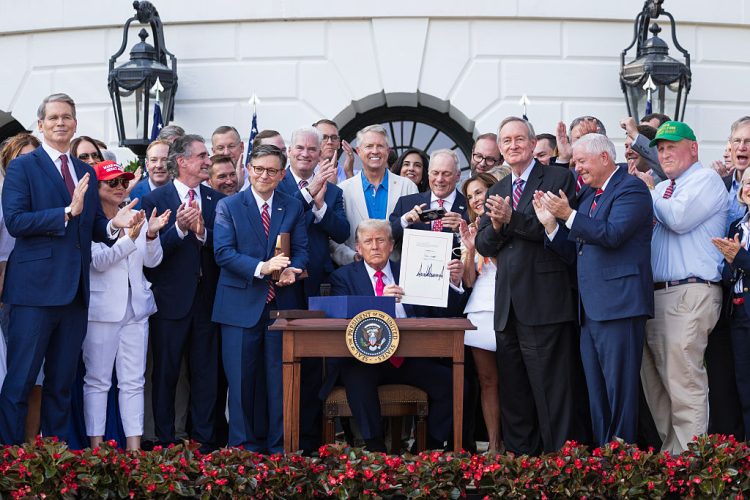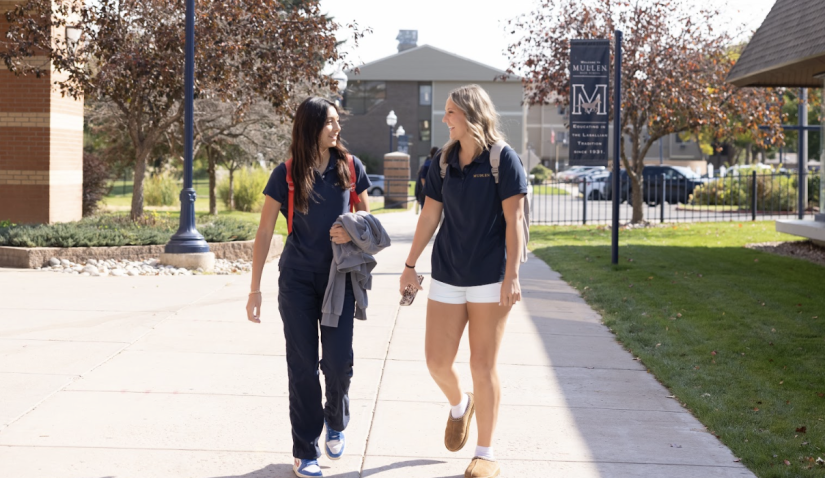School Choice: Nonprofits in Blue States See Opportunity in Federal Tax Credit
Observers say some Democratic leaders will only participate if they can “carefully regulate” the new program.

Get stories like this delivered straight to your inbox. Sign up for The 74 Newsletter
For 27 years, the BASIC Fund, a nonprofit, has awarded scholarships to help families in nine Bay Area counties in California to send their children to private school. CEO Rachel Elginsmith likes to collect testimonials from parents about what the financial assistance means to them.
“Private school gives us peace of mind,” Rolando Zamora, a father of two, wrote to her.
With a family of six living on one income, Chris Meija said the scholarship “certainly helped ease some of the financial burden.”
Organizations like the BASIC Fund, many of which are located in blue states, have operated out of the spotlight, quietly raising money from private donors to support kids from lower-income families. But now, with recent passage of the first-ever federal tax credit for private school choice, part of President Donald Trump’s “One Big Beautiful Bill,” they could soon be thrust into a public debate over the next phase of the school choice movement.
“We’ve been much more focused on just trying to help families and don’t want to get into the political fray, necessarily,” Elginsmith said. This fall, the BASIC Fund will help 3,100 students to attend 260 private schools. But with the federal tax credit coming in 2027, she can’t resist thinking about reaching more of the 300 to 500 applicants each year who don’t receive funding, she said. “We’re not against public schools; we just think that they aren’t the best thing for everybody.”

Ever since Trump gathered with Republicans on the South Lawn of the White House on July 4 to sign the bill, commentators have focused on one central question: What will blue states do? The Treasury Department still has to write rules for the program, but overall, the law allows taxpayers to get a dollar-for-dollar credit, up to $1,700, if they donate to a scholarship granting organization, like the BASIC Fund. Because the legislation lets states choose whether to participate, many assume that those under Democratic control will remain firmly opposed to anything that looks like a voucher. But Colyn Ritter, a senior research associate at EdChoice, an advocacy organization, said he “wouldn’t argue with anyone” who thinks states with existing scholarship programs would be in the best position to opt in.
BASIC is among several groups affiliated with the Children’s Scholarship Fund in New York, which annually helps about 7,000 students from low-income families across New York City attend private school. The nonprofit has partners that grant scholarships in Oregon, Massachusetts and New Jersey, to name a few other blue states.
“Those folks presumably have relationships with some state policymakers, which we think could be helpful,” said John Schilling, a consultant and adviser to the conservative American Federation for Children, a school choice advocacy group. He worked to keep the tax credit in the Republicans’ reconciliation bill, but is now shifting his attention to the states. Listing other Democratic strongholds, like Massachusetts and Illinois, he said, “These are places where parents desperately need some additional options.”
Supporters of the tax credit describe it as “free money” for education and argue it’s misleading to call it a voucher because the scholarships are funded by private donations — not federal funds directly. Still, tax experts predict the cost to the government could range anywhere from $8 billion to more than $100 billion per year, and opponents hope to convince political leaders and the public that the program is a bad idea.
“Whether you call it a voucher or a scholarship program … this is what’s going to happen,” former Education Secretary Miguel Cardona warned last month on a media call. “Public education dollars will be siphoned off to pay for vouchers for private schools that don’t have to accept all students. If students in many of these private schools struggle, they’re going to be sent back to these underfunded public schools.”
Others argue that private schools participating in choice programs aren’t subject to the same accountability and anti-discrimination requirements as public schools.
“There are no testing requirements, no standards, no teacher certification mandates or any other mechanisms to ensure that participating private schools would provide an adequate education to students,” said Patrick Cremin, a staff attorney for the Education Law Center, which is opposed to the program.
He doesn’t want blue states to be tempted by the fact that the federal program would also allow groups like BASIC to create scholarships for students in public schools. Families could put the money toward tutoring, books, therapies and technology — to name a few uses. Despite their “constitutional obligation to fund public schools,” there’s a risk, Cremin said, that states would shortchange districts if they expect taxpayers’ donations to cover some expenses.
Powerful political forces’
Because the tax credit doesn’t take effect for another year and a half, the debate over opting in could surface in the 38 states where voters will elect governors this year and next.
For now, choice advocates in California, where voters are expected to elect another Democrat when term-limited Gov. Gavin Newsom leaves office, aren’t hopeful about their prospects. Lizette Vallas, who runs a microschool in Los Angeles, blamed the union.
“The California Teachers Association is one of the most powerful political forces in the state. Any legislation or opt-in mechanism that diverts funding — even indirectly — from public schools to private or nontraditional models is almost always met with unified resistance,” she said. “While federal policy is nudging open the door for school choice, California continues to reinforce the frame around its own tightly held model.”
David Goldberg, the association’s president, calls the tax credit “a distraction.”
In other states, like Wisconsin and Michigan, the race for governor is considered a toss-up, meaning the federal tax credit has the potential to become a central campaign issue, said Joshua Cowen, a Michigan State University professor and Democrat who is also running for Congress.
The bill that included the tax credit is already causing budget challenges for state leaders, he said. Michigan, for one, is facing more than $1 billion in extra costs in 2026 because the federal package cut tax rates and shifted some nutrition and health care spending to states..
As a Democrat, Cowen said his party needs a platform that focuses on prioritizing support for public schools, but he said even governors who have been dead set against vouchers may have to consider how the tax credit could support programs like afterschool tutoring.
“States like mine are going to be desperate for new sources of revenue,” he said. “I could certainly see governors’ offices taking a look at this program — not because they necessarily love it — but because you’ve got revenue problems caused by the same exact bill that’s authorizing this.”

‘Families who are pinched the most’
Observers speculate that Pennsylvania could be the first blue state to opt in. Gov. Josh Shapiro came close to supporting an education savings account bill in 2023, and the state already offers two tax credit programs for corporations that donate to scholarships.
A February report from the conservative Commonwealth Foundation showed that only about half of the students who applied for aid in Pennsylvania during the 2022-23 school year received it. Those figures, school choice advocates say, are further evidence that demand from parents is soaring.
Illinois, another Democrat-led state, had a tax credit scholarship program, serving about 15,000 students, until lawmakers allowed it to expire in 2023. Nonprofits and Republican lawmakers are now urging Gov. J.B. Pritzker to participate in the federal program.
“Families and kids have borne the brunt of the program ending with many being unable to continue at their school or having to give up on the hope of attending their dream school,” said Bobby Sylvester, vice president of the Urban Center, a think tank. The tax credit “will cost Illinois nothing, but would make all the difference to the families who lost their scholarships.”
While not as solidly blue as Illinois, Colorado is the home state of ACE, another network of scholarship granting organizations. About $400,000 of the more than $11 million it awards in scholarships each year in the state goes to Mullen High School in Denver. The Christian Brothers, a Catholic congregation providing education to the poor, originally founded the school in the 1930s as an orphanage. Today, the 800-student Catholic school serves “some very rich kids and some super poor kids,” said Raul Cardenas Jr., president and CEO.
The financial support from ACE, he said, has been especially helpful to middle-income families who otherwise wouldn’t be able to fit private school in their budget. Two years ago, when he reduced scholarship awards for families in that income bracket by just $1,000, several left the school. This coming school year, leaders, he said “were very intentional about addressing that gap,” and if Colorado opts into the program, he would further expand financial assistance to those families.
“It’s always middle income families who are pinched the most,” he said. “I see this as a way to really help them.”

Voters in the Centennial State have resisted private school choice. Colorado is one of three states where the issue failed at the ballot box last year. A constitutional amendment would have created a right to the full array of options, including private schools and “future innovations in education.” The vote was extremely close, 50% to 49%. In two previous state elections, voters more decisively rejected vouchers, by a 2-1 margin in 1992 and with 60% of the vote in 1998.
Colorado might only opt into the federal program if the Treasury Department allows states the flexibility to “carefully regulate” scholarship granting organizations, said Kevin Welner, an education researcher at the University of Colorado Boulder.
Gov. Jared Polis, or his successor in 2026, could find the tax credit acceptable if “students in public schools receive the same level of benefits” as those in private schools, he said.
But Schilling, with American Federation for Children, would have a problem with states that approve organizations providing financial support to public school kids, but not those that supplement tuition at private schools.
“Blue state governors who want to remain in the good graces of the teachers’ unions may say ‘OK, I’ll opt in but we only want to serve students through public schools,’ ” he said. Regardless of which students the nonprofits want to serve, states, he said, “shouldn’t be picking and choosing.”
Get stories like these delivered straight to your inbox. Sign up for The 74 Newsletter

;)
